VISD-2004: Analyzing Times New Roman's Historical & Cultural Impact
VerifiedAdded on 2023/05/30
|8
|2219
|230
Essay
AI Summary
This essay provides an in-depth analysis of the Times New Roman typeface, examining its historical context, cultural significance, and aesthetic characteristics. Originating from The Times of London newspaper in 1931, Times New Roman quickly gained popularity and became a standard font across various media. The essay explores the relationship between typefaces and culture, highlighting how typography can convey both explicit and implicit messages. It evaluates Times New Roman's design, noting its narrower form suited for newspaper use, and discusses its classification as a transitional serif typeface. Furthermore, the essay delves into the psychological impact of typefaces, emphasizing how they influence the recipient's perception of information. It also touches upon the role of tradition, fashion, and trends in typography and advertising, illustrating how typefaces reflect and shape cultural perceptions. The essay concludes by asserting the enduring importance of typography as a crucial tool for communication.
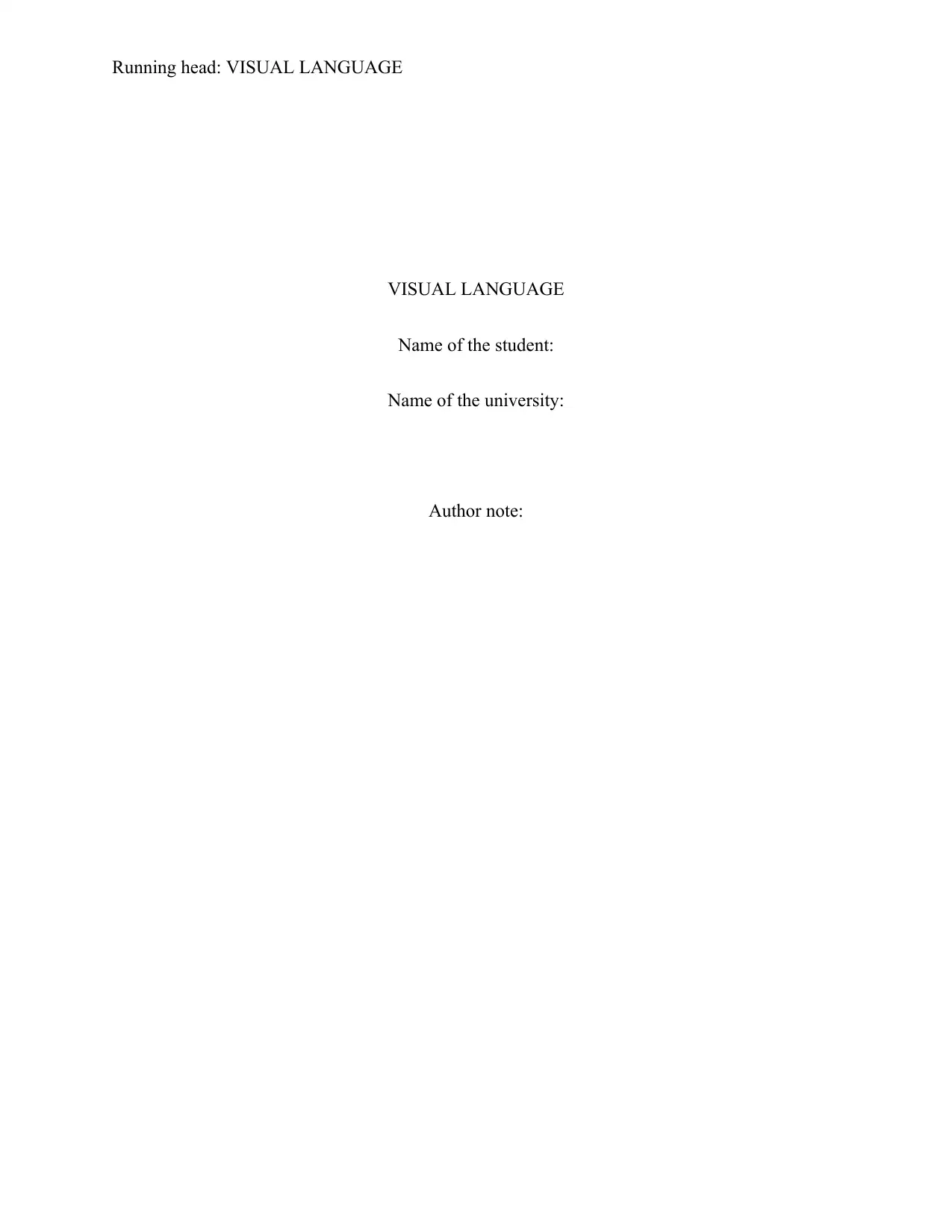
Running head: VISUAL LANGUAGE
VISUAL LANGUAGE
Name of the student:
Name of the university:
Author note:
VISUAL LANGUAGE
Name of the student:
Name of the university:
Author note:
Paraphrase This Document
Need a fresh take? Get an instant paraphrase of this document with our AI Paraphraser
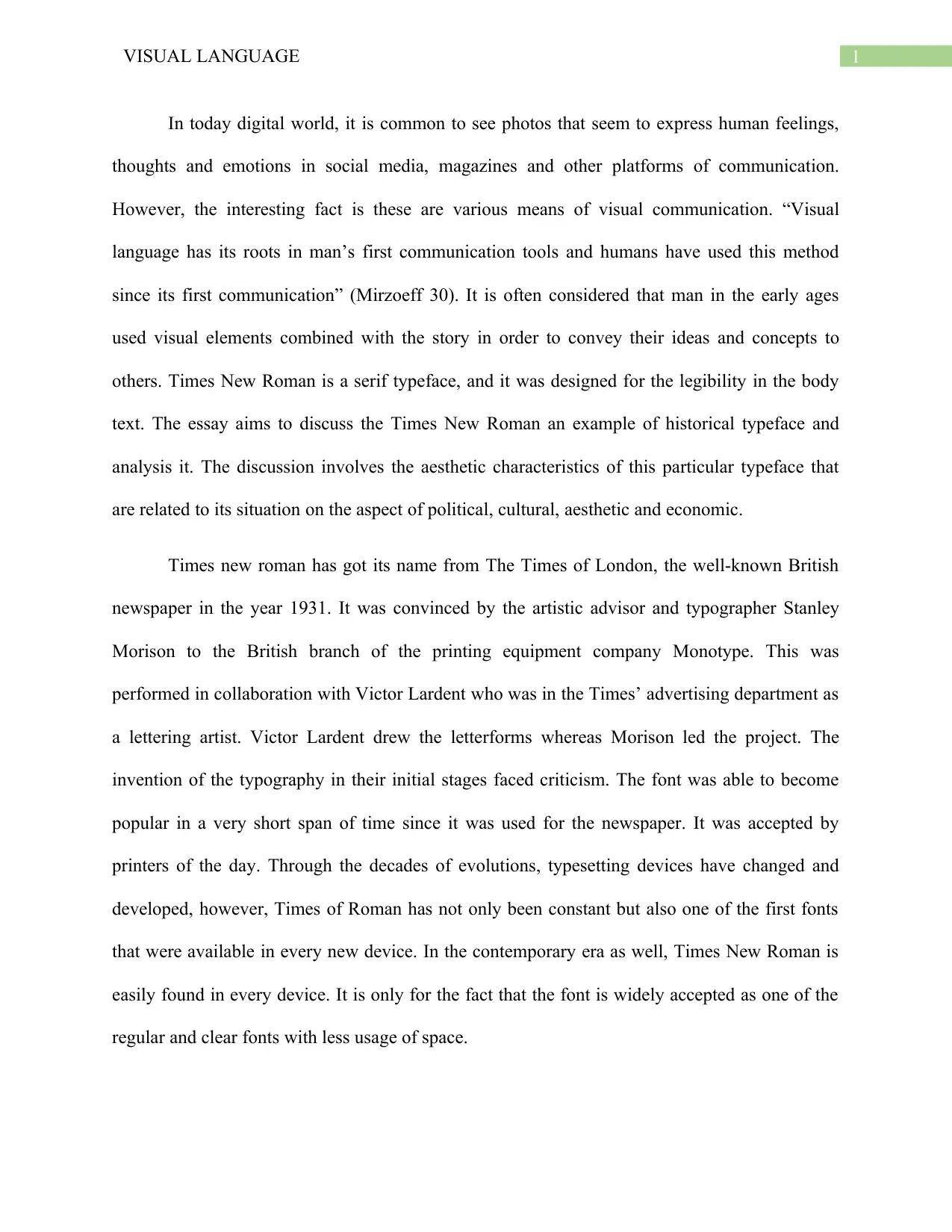
1VISUAL LANGUAGE
In today digital world, it is common to see photos that seem to express human feelings,
thoughts and emotions in social media, magazines and other platforms of communication.
However, the interesting fact is these are various means of visual communication. “Visual
language has its roots in man’s first communication tools and humans have used this method
since its first communication” (Mirzoeff 30). It is often considered that man in the early ages
used visual elements combined with the story in order to convey their ideas and concepts to
others. Times New Roman is a serif typeface, and it was designed for the legibility in the body
text. The essay aims to discuss the Times New Roman an example of historical typeface and
analysis it. The discussion involves the aesthetic characteristics of this particular typeface that
are related to its situation on the aspect of political, cultural, aesthetic and economic.
Times new roman has got its name from The Times of London, the well-known British
newspaper in the year 1931. It was convinced by the artistic advisor and typographer Stanley
Morison to the British branch of the printing equipment company Monotype. This was
performed in collaboration with Victor Lardent who was in the Times’ advertising department as
a lettering artist. Victor Lardent drew the letterforms whereas Morison led the project. The
invention of the typography in their initial stages faced criticism. The font was able to become
popular in a very short span of time since it was used for the newspaper. It was accepted by
printers of the day. Through the decades of evolutions, typesetting devices have changed and
developed, however, Times of Roman has not only been constant but also one of the first fonts
that were available in every new device. In the contemporary era as well, Times New Roman is
easily found in every device. It is only for the fact that the font is widely accepted as one of the
regular and clear fonts with less usage of space.
In today digital world, it is common to see photos that seem to express human feelings,
thoughts and emotions in social media, magazines and other platforms of communication.
However, the interesting fact is these are various means of visual communication. “Visual
language has its roots in man’s first communication tools and humans have used this method
since its first communication” (Mirzoeff 30). It is often considered that man in the early ages
used visual elements combined with the story in order to convey their ideas and concepts to
others. Times New Roman is a serif typeface, and it was designed for the legibility in the body
text. The essay aims to discuss the Times New Roman an example of historical typeface and
analysis it. The discussion involves the aesthetic characteristics of this particular typeface that
are related to its situation on the aspect of political, cultural, aesthetic and economic.
Times new roman has got its name from The Times of London, the well-known British
newspaper in the year 1931. It was convinced by the artistic advisor and typographer Stanley
Morison to the British branch of the printing equipment company Monotype. This was
performed in collaboration with Victor Lardent who was in the Times’ advertising department as
a lettering artist. Victor Lardent drew the letterforms whereas Morison led the project. The
invention of the typography in their initial stages faced criticism. The font was able to become
popular in a very short span of time since it was used for the newspaper. It was accepted by
printers of the day. Through the decades of evolutions, typesetting devices have changed and
developed, however, Times of Roman has not only been constant but also one of the first fonts
that were available in every new device. In the contemporary era as well, Times New Roman is
easily found in every device. It is only for the fact that the font is widely accepted as one of the
regular and clear fonts with less usage of space.
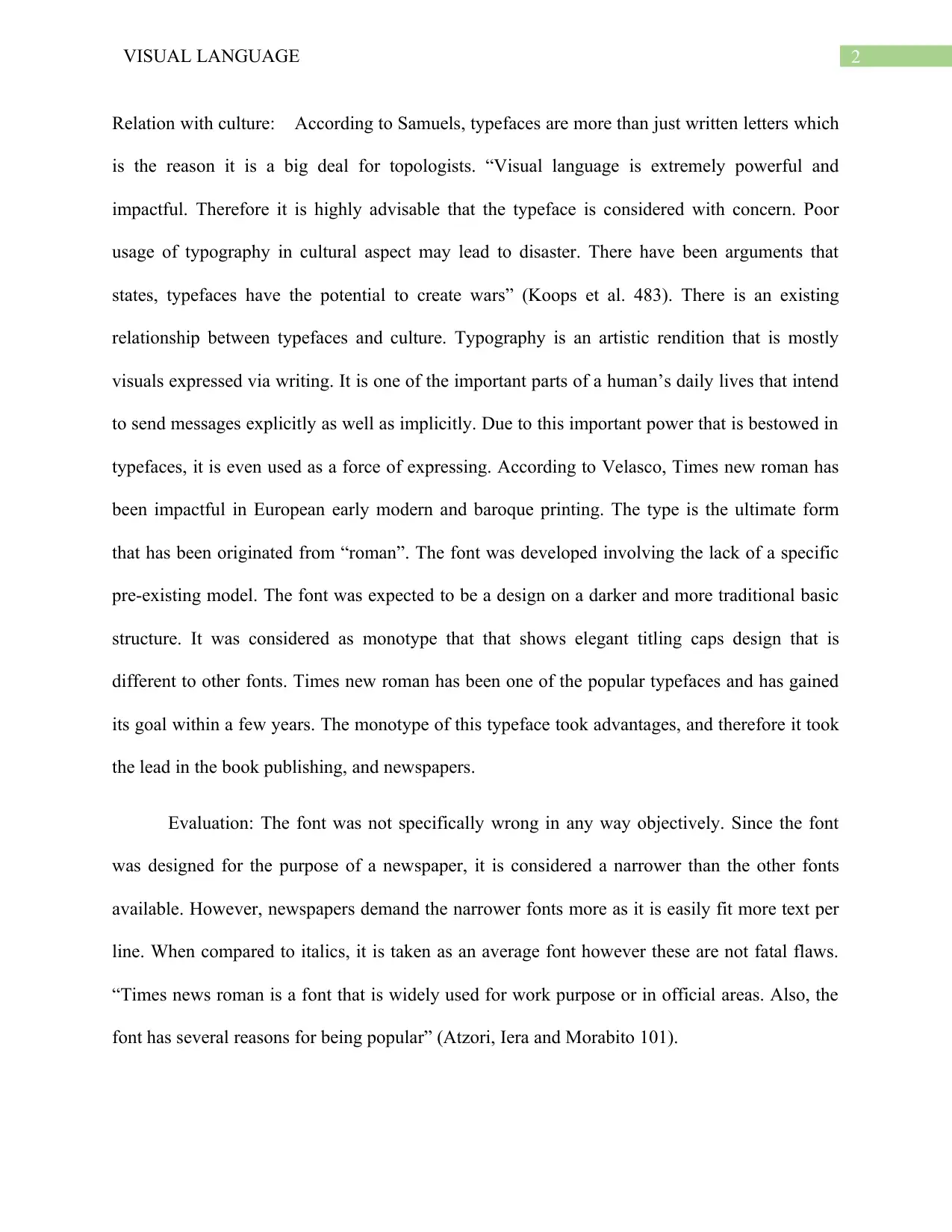
2VISUAL LANGUAGE
Relation with culture: According to Samuels, typefaces are more than just written letters which
is the reason it is a big deal for topologists. “Visual language is extremely powerful and
impactful. Therefore it is highly advisable that the typeface is considered with concern. Poor
usage of typography in cultural aspect may lead to disaster. There have been arguments that
states, typefaces have the potential to create wars” (Koops et al. 483). There is an existing
relationship between typefaces and culture. Typography is an artistic rendition that is mostly
visuals expressed via writing. It is one of the important parts of a human’s daily lives that intend
to send messages explicitly as well as implicitly. Due to this important power that is bestowed in
typefaces, it is even used as a force of expressing. According to Velasco, Times new roman has
been impactful in European early modern and baroque printing. The type is the ultimate form
that has been originated from “roman”. The font was developed involving the lack of a specific
pre-existing model. The font was expected to be a design on a darker and more traditional basic
structure. It was considered as monotype that that shows elegant titling caps design that is
different to other fonts. Times new roman has been one of the popular typefaces and has gained
its goal within a few years. The monotype of this typeface took advantages, and therefore it took
the lead in the book publishing, and newspapers.
Evaluation: The font was not specifically wrong in any way objectively. Since the font
was designed for the purpose of a newspaper, it is considered a narrower than the other fonts
available. However, newspapers demand the narrower fonts more as it is easily fit more text per
line. When compared to italics, it is taken as an average font however these are not fatal flaws.
“Times news roman is a font that is widely used for work purpose or in official areas. Also, the
font has several reasons for being popular” (Atzori, Iera and Morabito 101).
Relation with culture: According to Samuels, typefaces are more than just written letters which
is the reason it is a big deal for topologists. “Visual language is extremely powerful and
impactful. Therefore it is highly advisable that the typeface is considered with concern. Poor
usage of typography in cultural aspect may lead to disaster. There have been arguments that
states, typefaces have the potential to create wars” (Koops et al. 483). There is an existing
relationship between typefaces and culture. Typography is an artistic rendition that is mostly
visuals expressed via writing. It is one of the important parts of a human’s daily lives that intend
to send messages explicitly as well as implicitly. Due to this important power that is bestowed in
typefaces, it is even used as a force of expressing. According to Velasco, Times new roman has
been impactful in European early modern and baroque printing. The type is the ultimate form
that has been originated from “roman”. The font was developed involving the lack of a specific
pre-existing model. The font was expected to be a design on a darker and more traditional basic
structure. It was considered as monotype that that shows elegant titling caps design that is
different to other fonts. Times new roman has been one of the popular typefaces and has gained
its goal within a few years. The monotype of this typeface took advantages, and therefore it took
the lead in the book publishing, and newspapers.
Evaluation: The font was not specifically wrong in any way objectively. Since the font
was designed for the purpose of a newspaper, it is considered a narrower than the other fonts
available. However, newspapers demand the narrower fonts more as it is easily fit more text per
line. When compared to italics, it is taken as an average font however these are not fatal flaws.
“Times news roman is a font that is widely used for work purpose or in official areas. Also, the
font has several reasons for being popular” (Atzori, Iera and Morabito 101).
⊘ This is a preview!⊘
Do you want full access?
Subscribe today to unlock all pages.

Trusted by 1+ million students worldwide
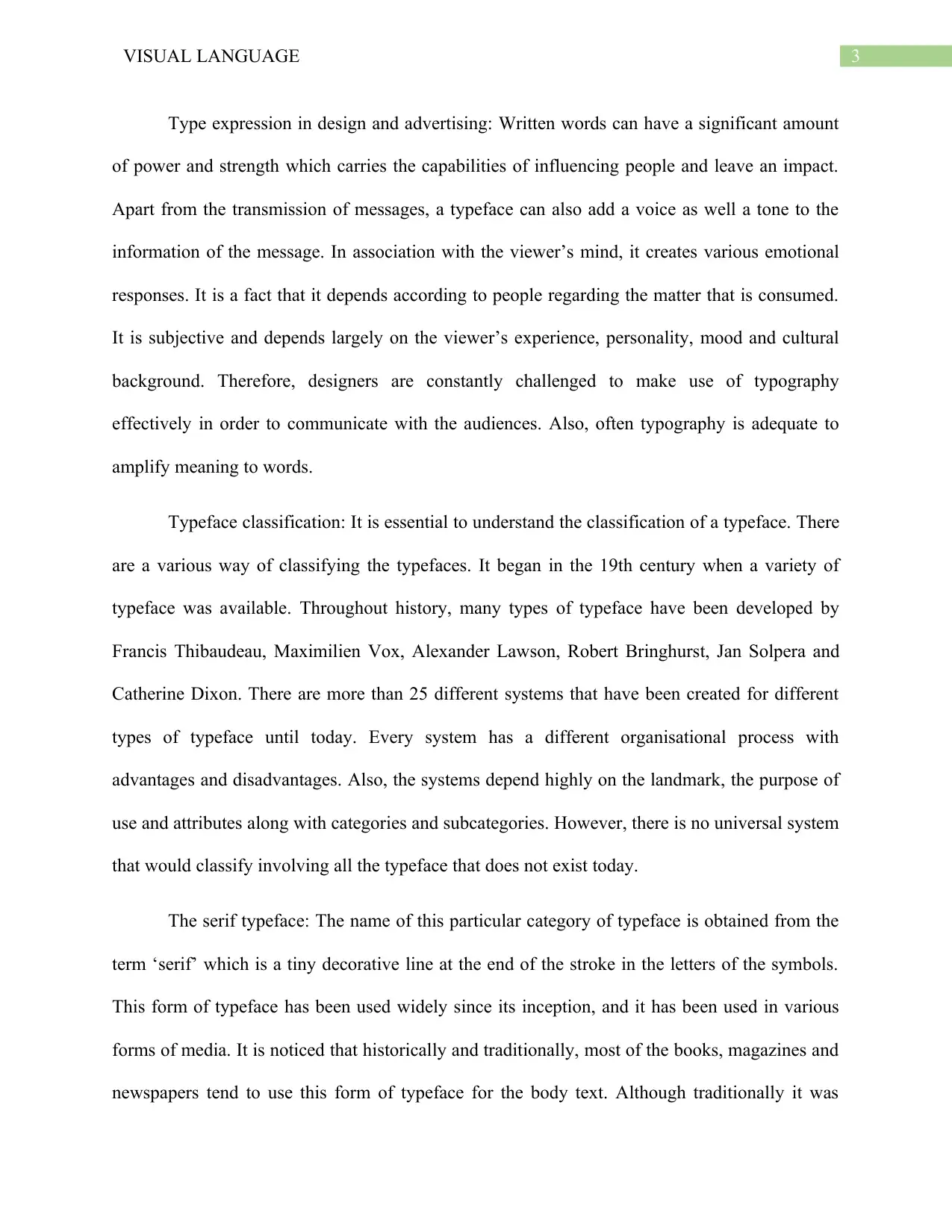
3VISUAL LANGUAGE
Type expression in design and advertising: Written words can have a significant amount
of power and strength which carries the capabilities of influencing people and leave an impact.
Apart from the transmission of messages, a typeface can also add a voice as well a tone to the
information of the message. In association with the viewer’s mind, it creates various emotional
responses. It is a fact that it depends according to people regarding the matter that is consumed.
It is subjective and depends largely on the viewer’s experience, personality, mood and cultural
background. Therefore, designers are constantly challenged to make use of typography
effectively in order to communicate with the audiences. Also, often typography is adequate to
amplify meaning to words.
Typeface classification: It is essential to understand the classification of a typeface. There
are a various way of classifying the typefaces. It began in the 19th century when a variety of
typeface was available. Throughout history, many types of typeface have been developed by
Francis Thibaudeau, Maximilien Vox, Alexander Lawson, Robert Bringhurst, Jan Solpera and
Catherine Dixon. There are more than 25 different systems that have been created for different
types of typeface until today. Every system has a different organisational process with
advantages and disadvantages. Also, the systems depend highly on the landmark, the purpose of
use and attributes along with categories and subcategories. However, there is no universal system
that would classify involving all the typeface that does not exist today.
The serif typeface: The name of this particular category of typeface is obtained from the
term ‘serif’ which is a tiny decorative line at the end of the stroke in the letters of the symbols.
This form of typeface has been used widely since its inception, and it has been used in various
forms of media. It is noticed that historically and traditionally, most of the books, magazines and
newspapers tend to use this form of typeface for the body text. Although traditionally it was
Type expression in design and advertising: Written words can have a significant amount
of power and strength which carries the capabilities of influencing people and leave an impact.
Apart from the transmission of messages, a typeface can also add a voice as well a tone to the
information of the message. In association with the viewer’s mind, it creates various emotional
responses. It is a fact that it depends according to people regarding the matter that is consumed.
It is subjective and depends largely on the viewer’s experience, personality, mood and cultural
background. Therefore, designers are constantly challenged to make use of typography
effectively in order to communicate with the audiences. Also, often typography is adequate to
amplify meaning to words.
Typeface classification: It is essential to understand the classification of a typeface. There
are a various way of classifying the typefaces. It began in the 19th century when a variety of
typeface was available. Throughout history, many types of typeface have been developed by
Francis Thibaudeau, Maximilien Vox, Alexander Lawson, Robert Bringhurst, Jan Solpera and
Catherine Dixon. There are more than 25 different systems that have been created for different
types of typeface until today. Every system has a different organisational process with
advantages and disadvantages. Also, the systems depend highly on the landmark, the purpose of
use and attributes along with categories and subcategories. However, there is no universal system
that would classify involving all the typeface that does not exist today.
The serif typeface: The name of this particular category of typeface is obtained from the
term ‘serif’ which is a tiny decorative line at the end of the stroke in the letters of the symbols.
This form of typeface has been used widely since its inception, and it has been used in various
forms of media. It is noticed that historically and traditionally, most of the books, magazines and
newspapers tend to use this form of typeface for the body text. Although traditionally it was
Paraphrase This Document
Need a fresh take? Get an instant paraphrase of this document with our AI Paraphraser
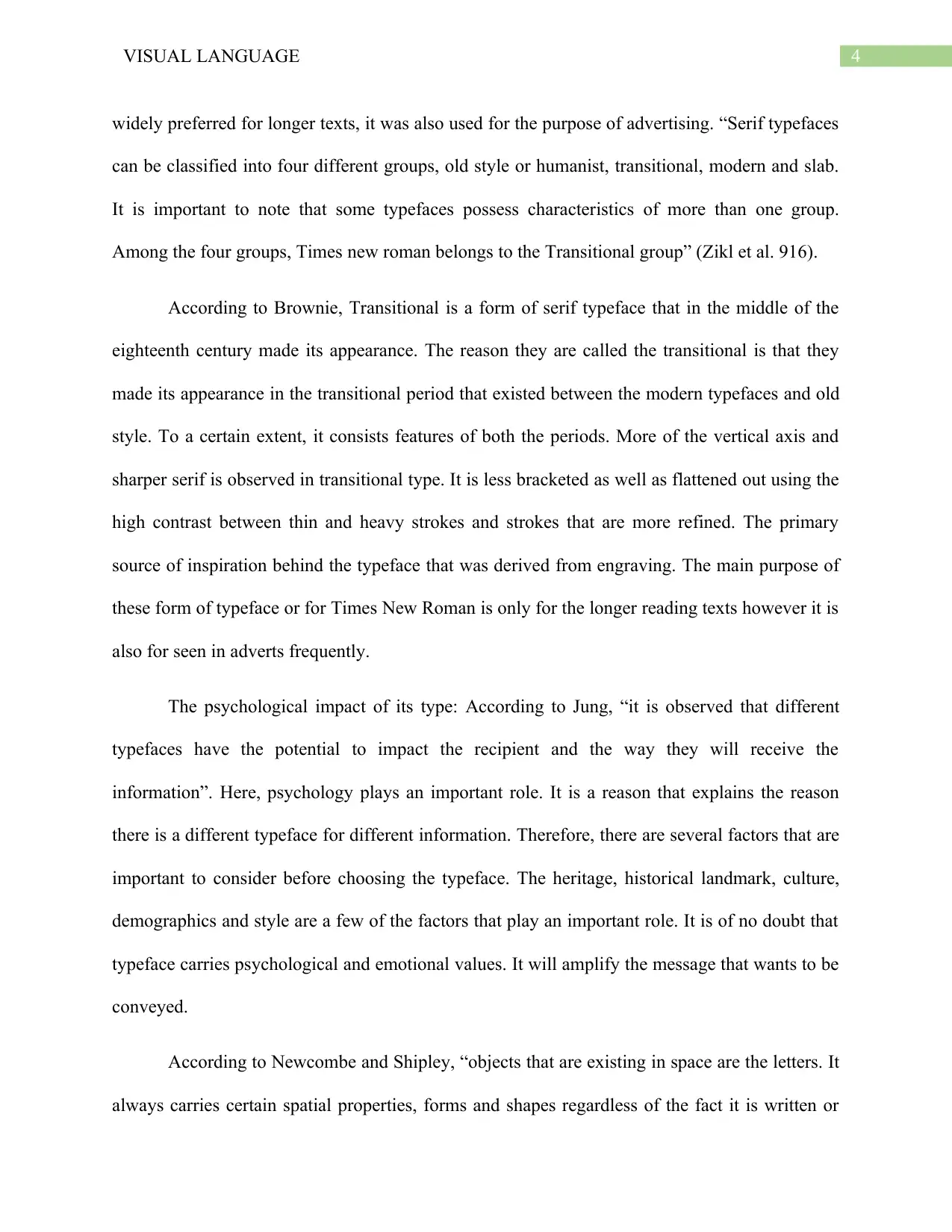
4VISUAL LANGUAGE
widely preferred for longer texts, it was also used for the purpose of advertising. “Serif typefaces
can be classified into four different groups, old style or humanist, transitional, modern and slab.
It is important to note that some typefaces possess characteristics of more than one group.
Among the four groups, Times new roman belongs to the Transitional group” (Zikl et al. 916).
According to Brownie, Transitional is a form of serif typeface that in the middle of the
eighteenth century made its appearance. The reason they are called the transitional is that they
made its appearance in the transitional period that existed between the modern typefaces and old
style. To a certain extent, it consists features of both the periods. More of the vertical axis and
sharper serif is observed in transitional type. It is less bracketed as well as flattened out using the
high contrast between thin and heavy strokes and strokes that are more refined. The primary
source of inspiration behind the typeface that was derived from engraving. The main purpose of
these form of typeface or for Times New Roman is only for the longer reading texts however it is
also for seen in adverts frequently.
The psychological impact of its type: According to Jung, “it is observed that different
typefaces have the potential to impact the recipient and the way they will receive the
information”. Here, psychology plays an important role. It is a reason that explains the reason
there is a different typeface for different information. Therefore, there are several factors that are
important to consider before choosing the typeface. The heritage, historical landmark, culture,
demographics and style are a few of the factors that play an important role. It is of no doubt that
typeface carries psychological and emotional values. It will amplify the message that wants to be
conveyed.
According to Newcombe and Shipley, “objects that are existing in space are the letters. It
always carries certain spatial properties, forms and shapes regardless of the fact it is written or
widely preferred for longer texts, it was also used for the purpose of advertising. “Serif typefaces
can be classified into four different groups, old style or humanist, transitional, modern and slab.
It is important to note that some typefaces possess characteristics of more than one group.
Among the four groups, Times new roman belongs to the Transitional group” (Zikl et al. 916).
According to Brownie, Transitional is a form of serif typeface that in the middle of the
eighteenth century made its appearance. The reason they are called the transitional is that they
made its appearance in the transitional period that existed between the modern typefaces and old
style. To a certain extent, it consists features of both the periods. More of the vertical axis and
sharper serif is observed in transitional type. It is less bracketed as well as flattened out using the
high contrast between thin and heavy strokes and strokes that are more refined. The primary
source of inspiration behind the typeface that was derived from engraving. The main purpose of
these form of typeface or for Times New Roman is only for the longer reading texts however it is
also for seen in adverts frequently.
The psychological impact of its type: According to Jung, “it is observed that different
typefaces have the potential to impact the recipient and the way they will receive the
information”. Here, psychology plays an important role. It is a reason that explains the reason
there is a different typeface for different information. Therefore, there are several factors that are
important to consider before choosing the typeface. The heritage, historical landmark, culture,
demographics and style are a few of the factors that play an important role. It is of no doubt that
typeface carries psychological and emotional values. It will amplify the message that wants to be
conveyed.
According to Newcombe and Shipley, “objects that are existing in space are the letters. It
always carries certain spatial properties, forms and shapes regardless of the fact it is written or
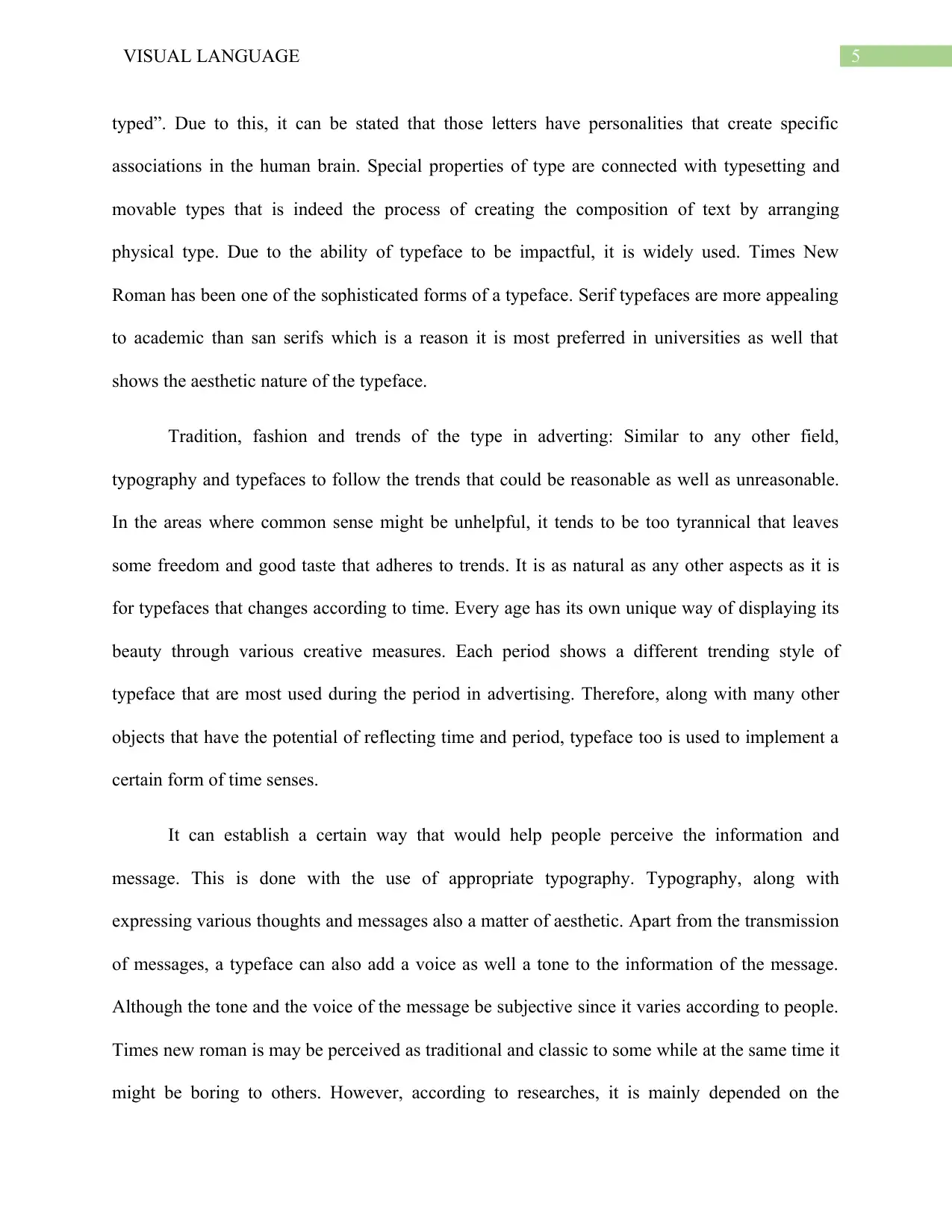
5VISUAL LANGUAGE
typed”. Due to this, it can be stated that those letters have personalities that create specific
associations in the human brain. Special properties of type are connected with typesetting and
movable types that is indeed the process of creating the composition of text by arranging
physical type. Due to the ability of typeface to be impactful, it is widely used. Times New
Roman has been one of the sophisticated forms of a typeface. Serif typefaces are more appealing
to academic than san serifs which is a reason it is most preferred in universities as well that
shows the aesthetic nature of the typeface.
Tradition, fashion and trends of the type in adverting: Similar to any other field,
typography and typefaces to follow the trends that could be reasonable as well as unreasonable.
In the areas where common sense might be unhelpful, it tends to be too tyrannical that leaves
some freedom and good taste that adheres to trends. It is as natural as any other aspects as it is
for typefaces that changes according to time. Every age has its own unique way of displaying its
beauty through various creative measures. Each period shows a different trending style of
typeface that are most used during the period in advertising. Therefore, along with many other
objects that have the potential of reflecting time and period, typeface too is used to implement a
certain form of time senses.
It can establish a certain way that would help people perceive the information and
message. This is done with the use of appropriate typography. Typography, along with
expressing various thoughts and messages also a matter of aesthetic. Apart from the transmission
of messages, a typeface can also add a voice as well a tone to the information of the message.
Although the tone and the voice of the message be subjective since it varies according to people.
Times new roman is may be perceived as traditional and classic to some while at the same time it
might be boring to others. However, according to researches, it is mainly depended on the
typed”. Due to this, it can be stated that those letters have personalities that create specific
associations in the human brain. Special properties of type are connected with typesetting and
movable types that is indeed the process of creating the composition of text by arranging
physical type. Due to the ability of typeface to be impactful, it is widely used. Times New
Roman has been one of the sophisticated forms of a typeface. Serif typefaces are more appealing
to academic than san serifs which is a reason it is most preferred in universities as well that
shows the aesthetic nature of the typeface.
Tradition, fashion and trends of the type in adverting: Similar to any other field,
typography and typefaces to follow the trends that could be reasonable as well as unreasonable.
In the areas where common sense might be unhelpful, it tends to be too tyrannical that leaves
some freedom and good taste that adheres to trends. It is as natural as any other aspects as it is
for typefaces that changes according to time. Every age has its own unique way of displaying its
beauty through various creative measures. Each period shows a different trending style of
typeface that are most used during the period in advertising. Therefore, along with many other
objects that have the potential of reflecting time and period, typeface too is used to implement a
certain form of time senses.
It can establish a certain way that would help people perceive the information and
message. This is done with the use of appropriate typography. Typography, along with
expressing various thoughts and messages also a matter of aesthetic. Apart from the transmission
of messages, a typeface can also add a voice as well a tone to the information of the message.
Although the tone and the voice of the message be subjective since it varies according to people.
Times new roman is may be perceived as traditional and classic to some while at the same time it
might be boring to others. However, according to researches, it is mainly depended on the
⊘ This is a preview!⊘
Do you want full access?
Subscribe today to unlock all pages.

Trusted by 1+ million students worldwide
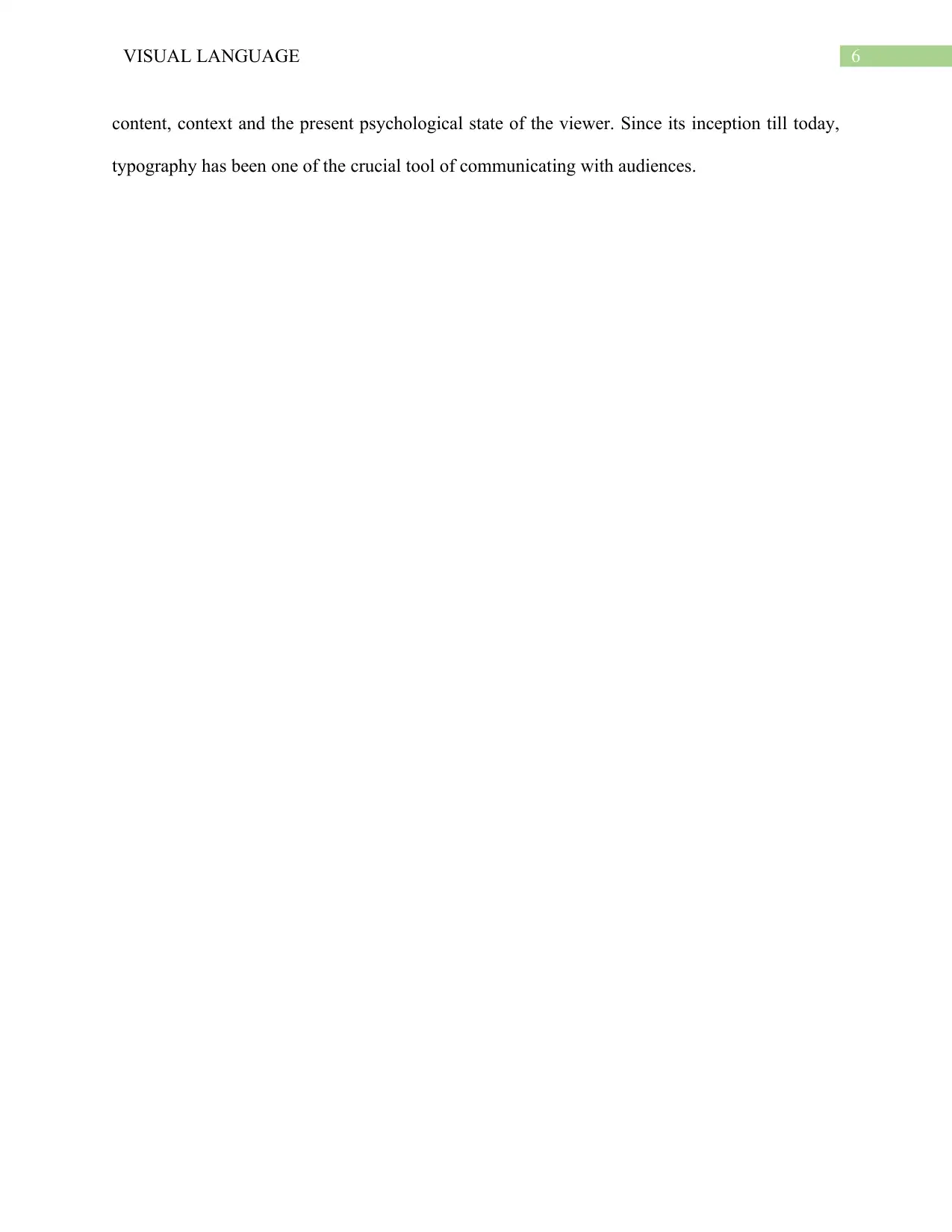
6VISUAL LANGUAGE
content, context and the present psychological state of the viewer. Since its inception till today,
typography has been one of the crucial tool of communicating with audiences.
content, context and the present psychological state of the viewer. Since its inception till today,
typography has been one of the crucial tool of communicating with audiences.
Paraphrase This Document
Need a fresh take? Get an instant paraphrase of this document with our AI Paraphraser
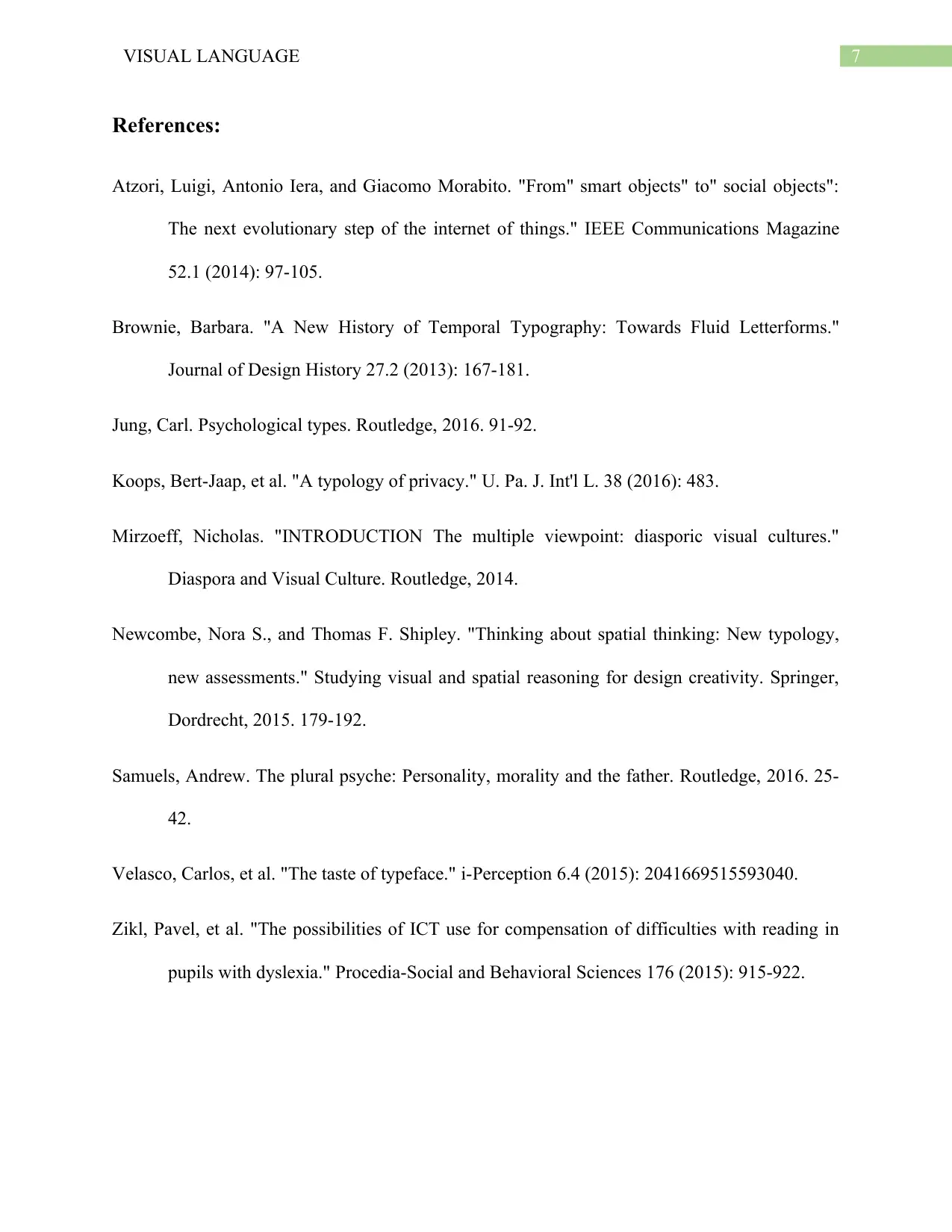
7VISUAL LANGUAGE
References:
Atzori, Luigi, Antonio Iera, and Giacomo Morabito. "From" smart objects" to" social objects":
The next evolutionary step of the internet of things." IEEE Communications Magazine
52.1 (2014): 97-105.
Brownie, Barbara. "A New History of Temporal Typography: Towards Fluid Letterforms."
Journal of Design History 27.2 (2013): 167-181.
Jung, Carl. Psychological types. Routledge, 2016. 91-92.
Koops, Bert-Jaap, et al. "A typology of privacy." U. Pa. J. Int'l L. 38 (2016): 483.
Mirzoeff, Nicholas. "INTRODUCTION The multiple viewpoint: diasporic visual cultures."
Diaspora and Visual Culture. Routledge, 2014.
Newcombe, Nora S., and Thomas F. Shipley. "Thinking about spatial thinking: New typology,
new assessments." Studying visual and spatial reasoning for design creativity. Springer,
Dordrecht, 2015. 179-192.
Samuels, Andrew. The plural psyche: Personality, morality and the father. Routledge, 2016. 25-
42.
Velasco, Carlos, et al. "The taste of typeface." i-Perception 6.4 (2015): 2041669515593040.
Zikl, Pavel, et al. "The possibilities of ICT use for compensation of difficulties with reading in
pupils with dyslexia." Procedia-Social and Behavioral Sciences 176 (2015): 915-922.
References:
Atzori, Luigi, Antonio Iera, and Giacomo Morabito. "From" smart objects" to" social objects":
The next evolutionary step of the internet of things." IEEE Communications Magazine
52.1 (2014): 97-105.
Brownie, Barbara. "A New History of Temporal Typography: Towards Fluid Letterforms."
Journal of Design History 27.2 (2013): 167-181.
Jung, Carl. Psychological types. Routledge, 2016. 91-92.
Koops, Bert-Jaap, et al. "A typology of privacy." U. Pa. J. Int'l L. 38 (2016): 483.
Mirzoeff, Nicholas. "INTRODUCTION The multiple viewpoint: diasporic visual cultures."
Diaspora and Visual Culture. Routledge, 2014.
Newcombe, Nora S., and Thomas F. Shipley. "Thinking about spatial thinking: New typology,
new assessments." Studying visual and spatial reasoning for design creativity. Springer,
Dordrecht, 2015. 179-192.
Samuels, Andrew. The plural psyche: Personality, morality and the father. Routledge, 2016. 25-
42.
Velasco, Carlos, et al. "The taste of typeface." i-Perception 6.4 (2015): 2041669515593040.
Zikl, Pavel, et al. "The possibilities of ICT use for compensation of difficulties with reading in
pupils with dyslexia." Procedia-Social and Behavioral Sciences 176 (2015): 915-922.
1 out of 8
Your All-in-One AI-Powered Toolkit for Academic Success.
+13062052269
info@desklib.com
Available 24*7 on WhatsApp / Email
![[object Object]](/_next/static/media/star-bottom.7253800d.svg)
Unlock your academic potential
Copyright © 2020–2025 A2Z Services. All Rights Reserved. Developed and managed by ZUCOL.